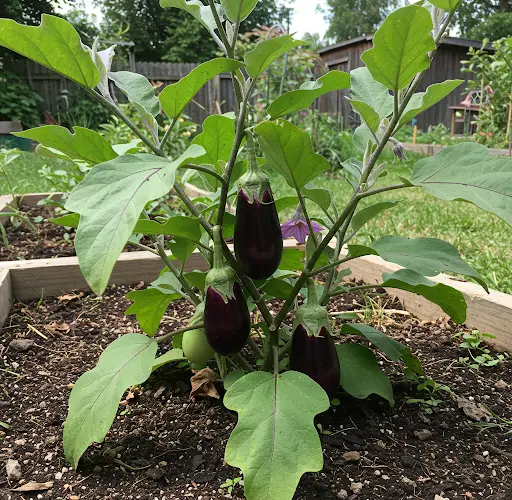How to Grow Eggplant at Home for High Yield and Surprising Productivity
Eggplant, also known as aubergine or brinjal, is a popular and versatile vegetable in home gardens. With its rich flavor and glossy purple skin, eggplant is used in countless dishes worldwide. The good news? You don’t need a farm or large garden to grow it. With the right techniques, you can successfully grow eggplant at home and enjoy a surprisingly productive harvest—often more than you expect from a single plant.
This guide will walk you through how to grow eggplant at home, with tips on soil, containers, sunlight, watering, and the secret to getting more fruits from your plant.
Why Grow Eggplant at Home?
Eggplant is not only delicious and nutritious but also relatively easy to grow once you know what it needs. A single healthy plant can produce dozens of fruits throughout the growing season. When grown under the right conditions, eggplants can be surprisingly productive—even in containers.
Plus, homegrown eggplants taste better than store-bought ones, as they’re fresher, pesticide-free, and harvested at the perfect stage of ripeness.
Choosing the Right Variety
Before planting, select the eggplant variety that best suits your space and climate. Common types include:
-
Black Beauty: Large, round purple fruits; ideal for container gardening
-
Thai or Indian Eggplants: Smaller and more compact; grow well in pots
-
Long Purple: Slender fruits, great for grilling or stir-fries
-
White Eggplant: Mild flavor and ornamental value
Choose a variety that matures quickly if you’re in a region with a short growing season.
Materials You’ll Need:
-
Eggplant seeds or healthy seedlings
-
Large container (at least 5 gallons or 12–14 inches deep) or garden bed
-
Organic potting mix or garden soil mixed with compost
-
Fertilizer or natural nutrients (e.g., compost, bone meal, banana peel tea)
-
Watering can or spray bottle
-
Support stakes or cages (optional but helpful)
-
A sunny location (at least 6–8 hours of sun daily)
Step-by-Step Planting Guide
1. Prepare the Container or Garden Bed
Eggplants need plenty of room for their roots to spread. Choose a deep container with drainage holes or a garden bed with well-aerated, fertile soil. Mix compost or well-rotted manure into the soil before planting.
2. Start from Seeds or Seedlings
If you’re starting from seeds, sow them indoors 6–8 weeks before the last frost. Transplant the seedlings outdoors once they’re about 6 inches tall and all risk of frost has passed.
If using seedlings, plant them directly in containers or the garden. Space plants at least 18–24 inches apart to give them room to grow and breathe.
3. Ensure Full Sunlight
Eggplant loves heat and sunlight. Place containers in a location that receives 6–8 hours of direct sun daily. Insufficient light can result in poor flowering and low fruit yield.
Watering and Feeding
Eggplants require consistent moisture. Water deeply and regularly, especially during hot weather. However, avoid overwatering, which can cause root rot. Let the top inch of soil dry out before watering again.
Feed your eggplant with organic fertilizer every 2–3 weeks during the growing season. Homemade compost tea, banana peel water, or diluted fish emulsion work well to promote flowering and fruit development.
For stronger productivity, sprinkle a bit of wood ash or crushed eggshells into the soil every month to boost potassium and calcium levels—essential for healthy fruit formation.
Supporting the Plant
As eggplants grow and begin to bear fruit, the weight of the produce can cause stems to bend or break. Install a small trellis, tomato cage, or stake next to the plant and loosely tie the main stem for support.
This not only prevents damage but also improves air circulation, reducing the risk of pests and diseases.
Encouraging More Fruits
To get more fruits from your eggplant:
-
Prune Lower Leaves: Remove leaves close to the soil to prevent fungal infection and redirect energy toward fruit production.
-
Pinch Early Flowers: Pinching the first few flowers encourages the plant to grow stronger and bushier before focusing on fruiting.
-
Pollinate by Hand: Eggplants self-pollinate, but shaking the plant gently or using a soft brush to move pollen between flowers can increase yield.
-
Harvest Frequently: Don’t wait too long to harvest—picking fruits early and often encourages the plant to produce more.
Pest and Disease Management
Watch out for common pests like aphids, spider mites, and flea beetles. Use neem oil spray or soapy water weekly as a natural remedy. If you spot holes in leaves or curled edges, inspect the plant closely and treat early.
To prevent disease, avoid overhead watering and always water the soil, not the leaves. Crop rotation and clean containers also help avoid soil-borne issues.
Harvesting
Eggplants are ready to harvest when the skin is glossy and firm. If the skin appears dull or the fruit feels soft, it may be overripe. Use a sharp knife or garden shears to cut the fruit with a small section of stem attached.
Harvest regularly to encourage more flowers and fruits. Depending on the variety, you can expect your plant to keep producing for several months in warm climates.
Conclusion
Growing eggplant at home can be a rewarding experience that yields far more than expected with just a little care and the right conditions. Whether in a garden bed or a simple container on your balcony, you can enjoy a continuous supply of fresh, flavorful eggplants all season long.
By following these simple steps—good soil preparation, consistent care, and strategic pruning—you’ll not only grow eggplants but turn one plant into a surprising productivity powerhouse.


